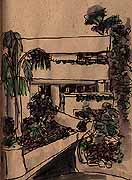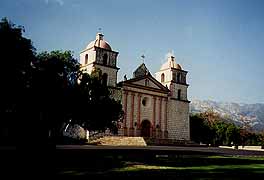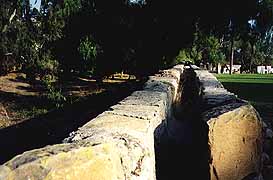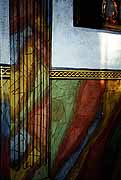American Sabbatical 046: 11/5/96
Santa Barbara
11/5.. Santa Barbara.
One of the great joys of riding on this wagontrain is getting to go face-to-face with fellow travelers. El Putz
(his e-mail handle.. aka Peggy’s cousin David) has been picking
plums on his wiseacerage since August, and shoving them down the
E-tube at us. Quite frankly I didn’t know what to expect when
we faced off here on the dream coast. In-laws, after all.
| All I knew about the Putz was that he’d retired from business
at a disgustingly early age, after making a killing selling mass-produced
art to motel chains.. that he was into boats and deepsea fishing..
and spent a lot of time in Baja. This was not a totally reassuring
resume. In his directions he’d described his house as looking
like the Guggenheim. Uh, ho. Are we talking about paintings on
velvet, or paintdrips in a BAH House? Climbing up the class spectrum
overlooking Santa Barbara didn’t increase my comfort level. I
tend to get airsick in the upper echelons. |

Museum of Kin
|
Not to worry. David is a mensch, and Carole is instant kin.. to
me, I mean. When we jumped out of the Owl, David gave me a big
hug in the dark, and I bloodied his lip. It was all uphill from
there. Their house IS a Guggenheim. Whitewashed cylinders and
slabs from the outside, the inside spirals round and round a central
stairwell, and the place is full of contemporary art. Neat art,
happy art, fun art, unpretentious art. A big playful shining white
house with terraces in all directions, profuse plantings, fountains,
fishponds, and not the least hint of condescension. The combination
of elegant modernity and egalitarian welcome is as refreshing
as it is uncommon. Who’d have thought you could feel at home in
a showplace in the upper lithosphere
It might have something to do with David and Carole who are absolutely
genuine, joyful hosts, with wideopen eyes, and a strong sense
of our human absurdity. It’s probably the echoes of all that laughter
which makes their “museum” a home. So how come we haven’t been
close to these cousins all our lives? Isn’t that the headshaker?
Too far, too busy, too many family briar patches in between. Br’er
Fox, if y’all goes spectin the worst of kinfolk, you might jes
find you ain’t so smart after all. Or maybe it’s only when we’ve
gone over the hill that we can appreciate the comfort of familiar
traits. In any case we felt blessed to be embraced by distant
kin come close.
Carole and David have full lives of community action. Carole goes
uptown and hobs with the nobs over issues of preservation and
development, while David goes downstreet and performs rescue missions
in the underclass. She mingles at city hall, he hangs out on the
waterfront. Touring Santa Barbara with them is a nonstop smooze
and howareyou? They make this city feel like a small town. But
what a spectacular small town. If you like California Spanish,
Santa Barbara will slay you. Civic legislation requires that all
buildings must be stylish, and every structure, from municipal
institutions to commercial malls to private haciendas play to
the same themes. Bright stucco walls in white, beige, yellow,
pink, roof tiles in shades of orange and red (now fiberglass vs.
ceramic), rounded archways, inner courtyards, shoal hipped towers,
all that Mission tradition, interspersed with walls of glass,
exploding in greenery and flowerworks, and waving fan palms in
the air. The County Courthouse is a raw sienna paean to the Spanish
style, with a glorious central tower pierced through with a two-story
barrel arch, and it dominates the business district just the way
the old mission rises above the secular housing around it. This
is a two and three story city, set on the flats between the pale
wash of the Pacific and the pinkorange and green mountains, then
climbing the hills toward the heights. From above, the city sparkles
white and red amidst the greenery, the tall palms lining the shoreline
stand like a row of feathery fenceposts against the water, the
offshore rigs march along like sentinels of industry, and the
Santa Barbara Islands loom up like a southsea dream. The breakwater-enclosed
boat basin is jammed tight with every variation on the nautical
theme, and there’s a 150 year waiting list for slippage.
David has a 31-foot whaler with twin 150s, and he took us out
for a cruise on election day. Talk about a scooter. We visited
pods of sea lions, who loll about in the arms of Neptune: tightly
clustered carpets of upraised flippers, and heads, and rolling
torsos. Periodically the beasts take it in their heads to party
on a moored boat and have sunk not a few with their cavorting.
Today they were hauled out on the bell and some large mooring
floats. Saki, the bearded collie who was our companion went about
nuts wanting to jump in and play. We saw mackerel running and
pelicans gorging, and got a good whiff of the deep salt.
The big storm we’d encountered at the mouth of the Columbia had
snatched up a handful of boats moored outside the Santa Barbara
breakwater and hurled them on the beach. We motored among their
dismasted hulks and watched the owners try to dig out one sailboat
still buried in the sands, then we nosed back into the harbor
thicket of masts and fiberglass. Everything from America’s Cuppers
to 50-foot trawlers out of Kodiak to sculling shells to antique
shrimp boats. The harbor was alive and thrumming 24 hours a day.

Santa Barbara Mission
(Bryce)
Right now the big squid run is on. Last night one boat offloaded
50 metric tons into reefers. Ultimate destination Japan. This
is a night fishery with a light boat to lure the inky cephalapods
and a purse seiner to set around them. Seiners from San Pedro
to the Aleutians are here, jockeying for position in the channel,
and sharemen are grinning ear to ear. We chatted up one crew from
Washington who grumbled like lobstermen about getting too many
sardines and the damn sharks ripping up the nets, and David offered
them showers and a place to put their feet up.
David compulsively brings home strays from off the dock or out
of the back streets. He is big brother to Vietnamese and Mexican
kids, and will as soon take in a homeless street warrior as a
wandering relative. He and Carole spend a couplethree months a
year way down in a small town in Baja, sharing their largess and
chasing the gamefish. David says they distribute the catch around
town and feel good about being rich sports. The only note of discontent
we heard from David was that he wants to sell the museum, because
it embarrasses him to bring street people there. Gives them the
wrong impression. But I found his joyful generosity and genuine
concern for others made the setting irrelevant. It looks cold,
but it feels warm. These folks give affluence a good name.
Back on the waterfront, the west coast fishery looked very healthy
to me. Crabbing, lobstering (didn’t even know there was a California
lobster), shrimping, salmon netting and trolling, groundfishing,
sardining, oyster farming. About the only plaint we heard was
the scarcity of abalone. The fishermen were all jawing about a
recent glut of salmon in the deeps off Alaska, where they’d had
to give away fish. Fishermen talked about the necessity of regulatory
shutoffs to preserve stocks as though that was the only sensible
thing to do. Am I hearing right? I didn’t smell a trace of the
graveyard attitude so frequent along our coast. Go west young
fisherman.
(Memo #40)
Nov. 5 - The MISSION OF SANTA BARBARA
Who? Franciscan missionaries
What? Greek-Roman-Spanish-Indian architected mission (10th in
California)
Where? Santa Barbara
When? established 1776
How? Spanish Crown authorized missions, Father Junipero Serra
started first 9
Topics: Spanish missions, mission architecture, mission activities,
Christianized Indians.
Questions: When and why were the Spanish mission established in
California? How did the missions operate? How were the indigenous
peoples treated? Whose life was described in Island of the Blue
Dolphins? |

Mission
|
The Catholic missionaries who were authorized by imperial Spain
to establish missions on the California coast served a dual purpose:
to Christianize the indigenous peoples (the church aim) and to
counter the Russian colonization threat (the crown aim) . Santa
Barbara (“the queen of the missions”) was the tenth mission established
by the Franciscans (the first nine being started by the famous
Father Junipero Serra). It is the only one of the California missions
that has been operated by the Franciscan fathers throughout its
history. Established in 1766, the mission belonged to Spain until
1821, then Mexico until 1848 , then the USA.
Today the mission buildings are fronted by lush lawns. A major
artery of the city of Santa Barbara winds past and houses crowd
in on every side. The coastal range looms in the background and
the ocean glitters a mile to the west. The mission is beautiful
- a huge church with adjoining cloisters and buildings surrounding
a spectacular central court. A small adjoining graveyard has the
graves of many missionaries, nuns, residents, Christianized First
People (including Juana Maria the woman whose life is the subject
of Island of the Blue Dolphins).
I had thought of the architecture as Spanish mission style; in
fact, it is a far more interesting blend of Greek, Roman, Spanish,
and First People/Native American traits. It has a Greco-Roman
facade and arches and columns, Islamic fountains and windows and
doors, First People/Native American color scheme and painted designs,
and Spanish towers, roofs and gardens.

Waterworks
|
The specific Greek traits are Ionic columns, entablature, architrave
and frieze. Apparently, the Greco-Roman influences can be explained
by contemporary publishing events. A Roman named Vitruvius Polion
wrote Ten Books of Architecture on Greek and Roman design in Latin.
During the Renaissance this book was distributed throughout Europe
and in 1787 it was translated into Spanish. This made it current
when the mission was rebuilt after an earthquake that devastated
the structure. The original adobe was replaced by stone covered
by stucco, now a lovely rose. The mission workers constructed
a still visible aqueduct to bring in water. |
The missionaries gathered the First People of the area - mainly
Chumash - in to a street of houses near the church (though there
were those that rejected Christianity and stayed away). They consciously
mixed groups, inculcated Catholicism, and turned the hunter-gatherers
into farmers. The mission culture blended people and plants and
animals and goods from many areas. From Mexico the missionaries
brought oranges, pomegranates, grapes, pears, beans, chilis, corn,
wheat, lettuce. The animals introduced included cattle, sheep,
pigs, mules, horses. Archaeologists have excavated the First Peoples’
areas at California missions.
The First People became the workers of the missions with a highly
structured schedule (but one that allowed a surprising amount
of leisure). Call to worship at 6:15, then 7 Mass, breakfast at
7:45, work assignments at 8:15, 11:15 to 1:30 was for a meal and
siesta, 1:30-3:00 was work time, Friday pm/Sat/Sun were free.
One fifth of the workers got a one week vacation every five weeks.They
worked as weavers, carpenters, saddlers, leatherworkers, blacksmiths,
potters, ranchhands, cooks, gardeners. (I saw no information on
what the First People received for their work.)
In one of the odder incidents (mentioned as an aside) in the mission’s
history, a missionary named Father Antonio Ripoll trained a company
of First People to face a military threat in 1818. It would be
an incredible event to research.
The First People of mission Santa Barbara intermarried with the
many ethnic groups represented by the Spanish soldiers and the
early settlers. Residents of the city today can trace their ancestry
back to Chumash, Mexican, Spanish, African-American, Sephardic
Jewish ancestors.
The mission’s fountain and water troughs can be seen in front
of the building. The rooms along the cloister have been turned
into a gift shop and small museum. Displays show the culture of
the Chumash Indians, mission trades and objects, a missionary’s
bedroom (complete with clothes, including large black hat, and
period furniture), the mission kitchen, artifacts belonging to
the first Bishop of California. A chapel room shows the original
mission altar, vestments, music books and instruments. The central
court (once used as a workshop by the First People workers) is
now a beautiful garden with trees and lawns and flower beds.
| The mission church is beautiful. I was particularly struck by
the walls where bright shapes outlined windows and doors and the
lower part of the church walls had an odd multicolored wavy sea
of paint. It turns out that the Chumash had elaborate polychrome
rock art as part of their religious rituals before the coming
of the missionaries. This distinctive polychrome style is their
gift to the mission. |

Polychrome
|
I wandered the mission on the self-tour, poking into corners and
imagining life in the 1800’s. Every place seemed to have decorations.
The physical plant itself is satisfying, but I still have many
questions about the life of the missions and the mixture of cultures.




